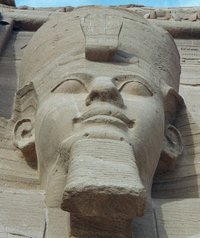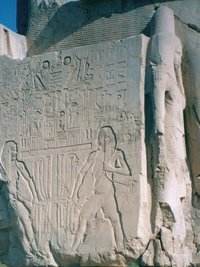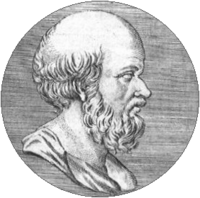Culture of Egypt
|
|
The Culture of Egypt has five thousand years of recorded history. Ancient Egypt was among the earliest civilizations. For millennia, Egypt maintained a strikingly complex and stable culture that had a profound influence on later cultures of Europe, the Middle East and Africa. After the Pharaonic era, Egypt itself came under the influence of Hellenism, for a time Christianity, and later, Arab and Islamic culture. Today, many aspects of Egypt's ancient culture exist in interaction with newer elements, including the influence of modern Western culture, itself with roots in Ancient Egypt.
Altes_Ägypten_003.jpg
| Contents |
Language
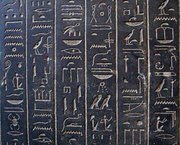
The Ancient Egyptian language, which formed a separate branch among the family of Afro-Asiatic languages, was among the first written languages, and is known from hieroglyphic inscriptions preserved on monuments and sheets of papyrus. The Coptic language, the only extant descendant of Egyptian, is today the liturgical language of the Coptic Orthodox Church.
The "Koiné" dialect of the Greek language was important in Hellenistic Alexandria, and was used in the philosophy and science of that culture, and was also studied by later Arabic scholars.
Arabic came to Egypt in the seventh century, and Egyptian Arabic has become the modern speech of the country. Of the many varieties of Arabic, it is the most widely spoken second dialect, probably due to the influence of Egyptian cinema throughout the Arabic-speaking world.
In the Upper Nile Valley, around Kom Ombo and Aswan, there are about 300,000 speakers of Nubian languages, mainly Nobiin, but also Kenuzi-Dongola. The Berber languages are represented by Siwi, spoken by about 5,000 around the Siwa Oasis. There are over a million speakers of the Domari language (an Indo-Aryan language related to Romany), mostly living north of Cairo, and there are about 60,000 Greek speakers in Alexandria. Approximately 77,000 speakers of Bedawi (a Beja language) live in the Eastern Desert.
Literature
Ancient Egyptian literature dates back to the Old Kingdom, in the third millennium BC. Religious literature is best known for its hymns to various gods and its mortuary texts. The oldest extant Egyptian literature are the Pyramid Texts: the mythology and rituals carved around the tombs of rulers. The later, secular literature of ancient Egypt includes the 'wisdom texts', forms of philosophical instruction. The Instruction of Ptahhotep, for example, is a collation of moral proverbs by an Egyptian administrator. The authors of the literature of the Old and Middle Kingdoms (through to the middle of the second millennium BC) seem to have been drawn from an elite administrative class, and were celebrated and revered into the New Kingdom (to the end of the second millennium). In time the Pyramid Texts became Coffin Texts (perhaps after the end of the Old Kingdom), and finally the mortuary literature produced its masterpiece, the Book of the Dead, during the New Kingdom.
During the Greco-Roman period (332 BC–AD 639), Egyptian literature was translated into other languages, and Greco-Roman literature fused with native art into a new style of writing. From this period comes the Rosetta Stone, which became the key to unlocking the mysteries of Egyptian writing to modern scholarship. The great city of Alexandria boasted its famous Library of almost half a million handwritten books during the third century BC. Alexandria's centre of learning also produced the Greek translation of the Hebrew Bible, the Septuagint.
During the first few centuries of the Christian era, Egypt was the ultimate source of a great deal of ascetic literature in the Coptic language. Egyptian monasteries translated many Greek and Syriac works, which are now only extant in Coptic.
Under Islam, Egypt continued to be a great source of literary endeavour, now in the Arabic language. In 970, al-Azhar University was founded in Cairo, which to this day remains the most important centre of Sunni Islamic learning. In the 12th century Egypt, the Jewish talmudic scholar Maimonides produced his most important work.
Among the modern talents of Egyptian literature, Naguib Mahfouz is foremost. In 1988, he was awarded the Nobel Prize for Literature. Other well-known Egyptian writers include Nawal El Saadawi, who is well known for her feminist works and activism, and Alifa Rifaat who is conservative and writes about women and tradition.
See also: List of writers from Egypt
Religion
Ancient Egyptian religion was a polytheistic system that saw the world as in conflict between forces of order and chaos. The Pharaoh, representative of order on Earth, was seen as divine and descended of the falcon god Horus. There was a strong cult of resurrection in the next life centered around the god Osiris.
Coptic Christianity became popular in the Roman and Byzantine periods, and Egypt was indeed one of the strongest early Christian communities. Today, Christians constitute about 10% of the population.
Islam in Egypt came to the country with the successors of Mohammed, and is today the dominant faith with 90% of the population adherents, almost all of the Sunni denomination.
Visual art
Egyptian art in antiquity
The Egyptians were one of the first major civilizations to codify design elements in art. The wall paintings done in the service of the Pharaohs followed a rigid code of visual rules and meanings. Early Egyptian art is characterized by absence of linear perspective, which results in a seemingly flat space. These artists tended to create images based on what they knew, and not as much on what they see. Objects in these artworks generally do not decrease in size as they increase in distance and there is little shading to indicate depth. Sometimes, distance is indicated through the use of tiered space, where more distant objects are drawn higher above the nearby objects, but in the same scale and with no overlapping of forms. People and objects are almost always drawn in profile.
Early Egyptian artists did have a system for maintaning dimensions within artwork. They used a grid system that allowed them to create a smaller version of the artwork, and then scale up the design based upon proportional representation in a larger grid.
See also: African art#Egypt
Egyptian art in modern times
Modern and contemporary Egyptian art can be as diverse as any works in the world art scene. One artist who brings a particular Egyptian influence to his work is Mohamed Fathy Abouelnaga. The foundation of Mr. Abouelnaga's work is paper making, and he creates his paper much as ancient Egyptian created papyrus. It is composed of organic material such as tree bark and palm fibers. In the words of the artist, the paper is an "ecological surface" which he then paints using natural pigments.
Science
Egypt's cultural contributions have included great works of science dating from antiquity to modern times.
Ptolemy
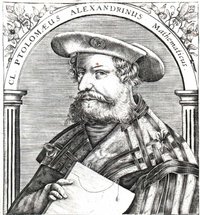
Ptolomy is one of the most famous scientists associated with Egypt. Although he was born in Greece, he is famous for his work in Alexandria. Born Claudius Ptolemaeus (Greek: Κλαύδιος Πτολεμαίος; c. 85 – c. 165),he was a Greek geographer, astronomer, and astrologer. He is considered by many to be the father of astronomy.
Ptolemy was the author of two important scientific treatises. One is the astronomical treatise that is now known as the Almagest (in Greek Η μεγάλη Σύνταξις, "The Great Treatise"). In this work, one of the most influential books of Antiquity, Ptolemy compiled the astronomical knowledge of the ancient Greek and Babylonian world.
Ptolemy's other main work is his Geography. This too is a compilation, of what was known about the world's geography in the Roman Empire in his time.
In his Optics, a work which survives only in a poor Arabic translation, he writes about properties of light, including reflection, refraction and colour. His other works include Planetary Hypothesis, Planisphaerium and Analemma.
Ptolemy's treatise on astrology, the Tetrabiblos, was the most popular astrological work of antiquity and also enjoyed great influence in the Islamic world and the medieval Latin West.
Ptolemy also wrote an influential work Harmonics on music theory. After criticizing the approaches of his predecessors, Ptolemy argued for basing musical intervals on mathematical ratios (in contrast to the followers of Aristoxenus) backed up by empirical observation (in contrast to the overly-theoretical approach of the Pythagoreans). He presented his own divisions of the tetrachord and the octave, which he derived with the help of a monochord. Ptolemy's astronomical interests also appeared in a discussion of the music of the spheres.
Tributes to Ptolemy include Ptolemaeus crater on the Moon and Ptolemaeus crater on Mars.
Eratosthenes
Another important scientist of Hellenistic Egypt was Eratosthenes. He was the first to measure Earth's circumference. He also measured a number of other important astronomic distances, such as the Sun-Earth distance, and introduced the Sieve of Eratosthenes – a way of finding prime numbers.
Library of Alexandria
Alexandria-inscription.jpg
The Royal Library of Alexandria was once the largest in the world. It is usually assumed to have been founded at the beginning of the 3rd century BC during the reign of Ptolemy II of Egypt after his father had set up the Temple of the Muses or Museum. The initial organization is attributed to Demetrius Phalereus. The Library is estimated to have stored at its peak 400,000 to 700,000 scrolls.
One of the reasons so little is known about the Library is that it was lost centuries after its creation. All that is left of many of the volumes are tantalizing titles that hint at all the history lost due to the building's destruction. Few events in ancient history are as controversial as the destruction of the Library, as the historical record is both contradictory and incomplete. Its destruction has been attributed by some authors to, among others, Julius Caesar, Augustus Caesar, and Catholic zealots during the purge of the Arian heresy. Not surprisingly, the Great Library became a symbol of knowledge itself, and its destruction was attributed to those who were portrayed as ignorant barbarians, often for purely political reasons.
A new library was inaugurated in 2003 near the site of the old library.
Ahmed Hasan Zewail
Ahmed H. Zewail (Arabic: أحمد زويل) (born February 26, 1946) is an Egyptian chemist, and the winner of the 1999 Nobel Prize in Chemistry for his work on femtochemistry. Born in Damanhur (60km south-east of Alexandria) and raised in Disuq, he moved to the US to complete his PhD at the University of Pennsylvania. He was awarded a faculty appointment at Caltech in 1976, where he has remained since.
Zewail's key work has been as the pioneer of femtochemistry - i.e. the study of chemical reactions across femtoseconds. Using a rapid ultrafast laser technique (consisting of ultrashort laser flashes), the technique allows the description of reactions at the atomic level. It can be viewed as a highly sophisticated form of flash photography.
In 1999, Zewail became the third Egyptian to receive the Nobel Prize, following Anwar Sadat (1978 in Peace) and Naguib Mahfouz (1988 in Literature). In 1999 he received Egypt's highest state honour, the Grand Collar of the Nile.
Egyptology
In modern times, archaeology and the study of Egypt's ancient heritage as the field of Egyptology has itself become a major scientific pursuit in the country. Led at first by Westerners, this modern rediscovery has in recent decades been taken up by Egyptian archeaologists such as Zahi Hawass and the Supreme Council of Antiquities he leads. None of this could have taken place, though, without the discovery of the Rosetta Stone, a tablet written in ancient Greek, Egyptian demotic script, and Egyptian hieroglyphs. Greek, a well known language, gave linguists the ability to decipher the mysterious Egyptian hieroglyphic language. The ability to decipher hieroglyphics facilitated the translation of hundreds of the texts and inscriptions that were previously indecipherable, giving us insight into Egyptian culture that would have otherwise been lost to the ages. The stone was discovered on July 15, 1799 in the port town of Rosetta, Egypt,and has been held in the British Museum since 1802.
Music and dance
- Main article: Music of Egypt
Oud.jpg
Egyptian music is a rich mixture of indigenous, Arabic, African and Western influences.
As early as 4000 BC, ancient Egyptians were playing harps and flutes, as well as two indigenious instruments: the ney and the oud. However, there is no notation of Egyptian music before the 7th century AD, when Egypt became part of the Arab world. Percussion and vocal music became important at this time, which has remained an important part of Egyptian music today.
From the 1910s, Egyptian pop music has become increasingly listened to, as has folk music from Egypt's many cultures. This enhances the sense of place which is part of the Arab influence in Egyptian music.
In the last quarter of the 20th century, Egyptian music was a way to communicate social and class issues. One popular modern pop singer is Amr Diab.
Belly dance, or Raqs Sharqi in Arabic, may have originated in Egypt, and today the country is considered the international center of the art.
See also
- List of Egyptians
- Rosetta stone
- The Category:Ancient Egypt lists the Egyptian Pyramids, for example
External links
- "The Library of Alexandria" (http://www.perseus.tufts.edu/GreekScience/Students/Ellen/Museum.html) by Ellen N. Brundige
- Bibliotheca Alexandrina (http://www.bibalex.org/)
- Ahmed H. Zewail's website at CalTech (http://www.its.caltech.edu/~femto/)
- The Art of Ancient Egypt (http://www.metmuseum.org/explore/newegypt/htm/a_index.htm)
- Egyptian contributions to art (http://www.ndoylefineart.com/design2.html)
- Cairo Opera House (http://www.operahouse.gov.eg/)pt:Cultura do Egipto

